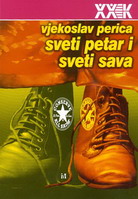 Perica,Vjekoslav – Saint Peter and Saint Sava. Sacred Symbols as Metaphors of Historical Change
Perica,Vjekoslav – Saint Peter and Saint Sava. Sacred Symbols as Metaphors of Historical Change
2009, pp. 220
Price $5.50
Vjekoslav Perica was born in Split, where he graduated from a classics highschool before attending and completing the course of study at the law school in the same city. Before the war, in former Yugoslavia, he wrote the column ”Faith and Politics” regularly appearing in ”Sunday Dalmatia” (1988 – 1991). In 1991, he arrived in the United States, where he earned an MA degree in political science and a PhD in history at the University of Minnesota – Twin Cities. He worked as a researcher at a US Institute for Peace and at the International Resarch Center ”Woodrow Willson”. He also taught at several universities (U. Of Minnesota, U. of Utah, U. of Southern Illinois, etc.). In 2007, he was a Fulbright scollar in Belgrade. He published a number of works in scholarly publications, most them dealing with issues of church and politics in the Balkans. He published in English a study entitled The Balkan Idols. Religion and Nationalism in the Yugoslav States. Oxford University Press, New York, 2002 (translated into Serbo-Croatian and published by The 20th Century Library in 2006). Since 2008, Perica has been a professor at the Rijeka University School of Arts.
This book follows the realization o two construction projects in Split, the building of two churches, symbolically linked to each other for over half a century: the added cathedral of St. Peter the Apostle and the Serbian-Ortodox memorial temple of Saint Sava. The bacground of the problems accompanying the building of these churches is made up of crucial historical developments in the area of a common state of Southern Slavs and in the territories of its ethnic heir-states. The two houses of God are identity symbols of distinct peoples and nations, mirrors and metaphors of Serbo-Croation relations. Their interaction in the context of historical change reveals the character of actual relationship between church and state, and simultaneously, between different churches within the process of reconstruction in different new states.



